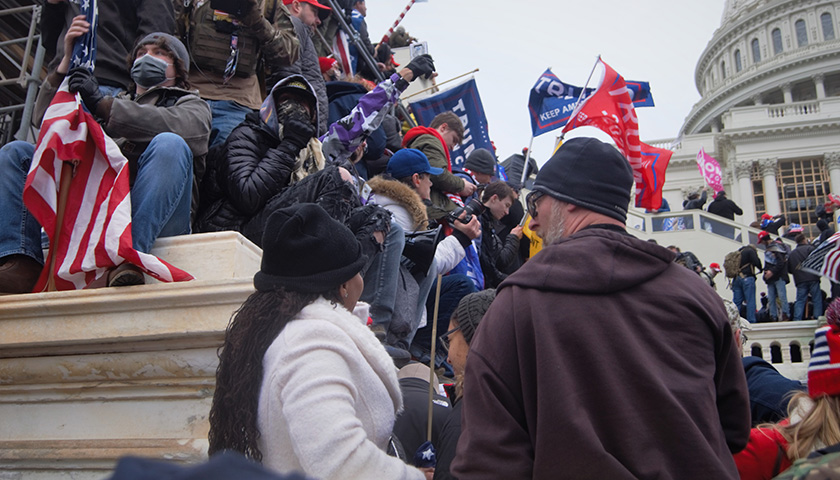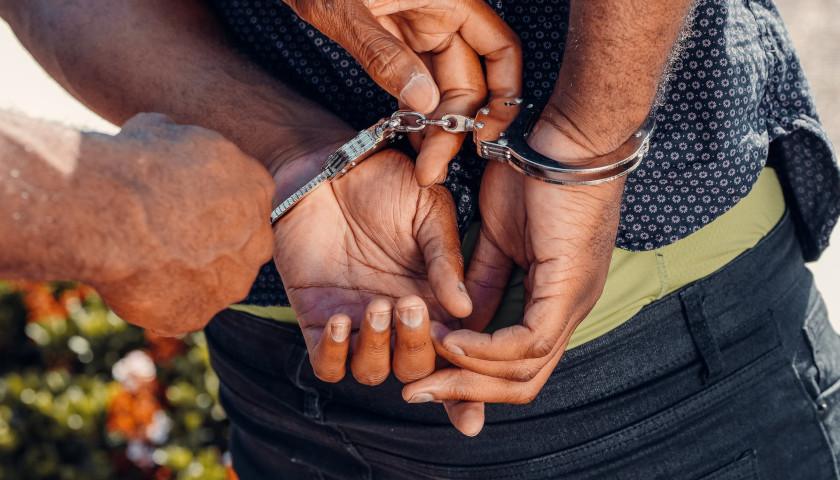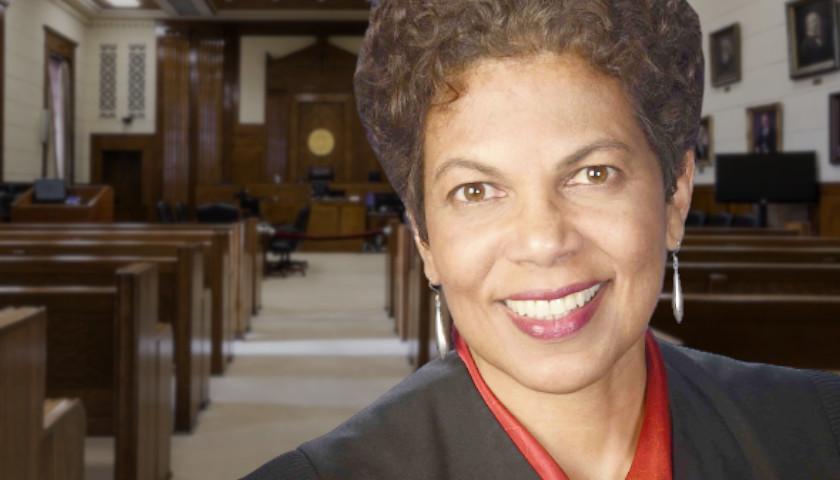by Jack Cashill
For those who do not know who Ray Epps is and why he matters—and this includes most Democrats and many journalists—U.S. Representative Paul Gosar (R-Ariz.) served up a handy reference guide last week. Gosar did this in the form of a resolution of inquiry (ROI) directing Attorney General Merrick Garland to hand over all documents relevant to the Epps case within 14 days.
“Multiple videos show Ray Epps repeatedly urging crowds of people in Washington, D.C. on January 5 and January 6, 2021, to go to the United States Capitol and breach the building,“ Gosar explained. “Epps is the one person seen on video directing people towards the Capitol seconds before violence broke out, yet he has never been arrested or charged with any crime while more than 800 others have and countless more remained jailed.”
During a House Judiciary Committee hearing on Wednesday of last week, Rep. Thomas Massie (R-Ky.) went into more detail, showing numerous video clips and citing Epps’ own admission, captured on video, “I’ll probably go to jail for this. I’ll probably be arrested.”
Epps had good reason to worry. In his red Trump hat and camo gear, a head taller than those around him, Epps was the most conspicuous of all the January 6 protestors. In fact, he was the only one caught on camera urging others to “go in to the Capitol,” which he did repeatedly on January 5. So suspicious was his behavior that his fellow protestors chanted “no, no, no” and “Fed, Fed, Fed,” over one of his many exhortations.
One video from January 6 shows Epps telling a protester, “When we go in, leave this here. We don’t need to get shot.” The unseen “this” was likely a weapon, perhaps a gun. More damning still, another video captures Epps whispering into the ear of a protester seconds before the young man helped make the first breach of the Capitol Police’s inept defenses.
Epps certainly caught the attention of the FBI. Early on, the bureau posted a video and photo of Epps—No. 16 on the FBI hit list—under the rubric, “Seeking information: Violence at the United States Capitol.” The New York Times noticed too. Its producers featured the January 5 clip of Epps urging protesters to go “in to the Capitol” in its own July 2021 video, “Day of Rage: How Trump Supporters Took the U.S. Capitol.” More than 8 million people have seen Epps in action on that video.
Later in July 2021, however, the FBI quietly removed Epps from its most-wanted list. He was not arrested and never spent a night in jail. The failure of the FBI to arrest the most conspicuous ringleader of the Capitol breach has naturally heightened suspicions that Epps—and likely others—were either federal agents or assets.
The “journalists” at the New York Times did not share those suspicions. In July 2022, in an article destined for the Walter Duranty wing of the Gray Lady’s archives, Times reporter Alan Feuer lamented the fate of this seeming MAGA extremist. “Epps has suffered enormously in the past 10 months,” wrote Feuer, “as right-wing media figures and Republican politicians have baselessly described him as a covert government agent who helped to instigate the attack on the Capitol last year.”
“Baselessly?” The fact that the Times would shred its remaining credibility to defend this man suggests just how much Epps matters. As a point of reference, he matters much the way Alger Hiss did more than 70 years ago. In August 1948, former Communist Whittaker Chambers testified before the House Un-American Activities Committee (HUAC) that Hiss, a State Department advisor to President Franklin Roosevelt, was a Soviet asset.
Once Hiss was accused, the establishment media and the Democratic Party rushed to his defense. To acknowledge his guilt was to accept the accusations by the Republicans on HUAC, a young Richard Nixon most prominently among them, that Soviet agents had penetrated deep into the Roosevelt and Harry Truman Administrations. Hiss had to be defended at all costs.
For comparable reasons, the media and the Democrats feel compelled to defend Ray Epps. To acknowledge that Epps was a government asset is to acknowledge that he and others like him infiltrated the January 6 protest and spurred it to violence. Like Hiss, Epps has come to bear the weight of a powerful narrative. That narrative includes the notion, floated at the hearing by Rep. Mondaire Jones (D-N.Y.), that a Capitol police officer was “bludgeoned to death” on January 6. If Jones believes a falsehood of this consequence, most Democrats probably do as well.
The vehemence of the Democrats’ opposition to Gosar’s resolution showed just how desperate they are to preserve their version of events at least through November.
No one on the committee matched Rep. Jamie Raskin (D-Md.) for the sheer venom of his attacks. Raskin, who also serves on the January 6 committee, denounced his GOP colleagues for their “absurd whining about Ray Epps who has absolutely nothing to do with any of it.”
To distract from the simple request at hand, namely to see the Justice Department’s documentation on Epps and other government assets, Raskin turned his fury on Donald Trump and anyone who supported him—“the autocrats, the kleptocrats, the bullies, the tyrants, and despots.”
To his credit, Massie kept his cool. He understood what was at stake. For more than a year Republicans on the Judiciary Committee have been pressing the FBI and Justice Department officials for information relevant to Epps, and they have been stonewalled at every turn.
“You are not going to memory hole this,” Massie protested. “There were cameras everywhere. You can create your own thesis for what happened, but if your thesis is in contradiction with things that hundreds of millions can observe and no one disputes, you have to resolve that.”
Initially, the evidence against Hiss consisted of little more than the word of Chambers. Under pressure from his allies, Hiss sued Chambers for libel. In the subsequent libel trial, the specificity of Chambers’ testimony and supporting documentation convinced dispassionate observers that Hiss was, in fact, a liar and a Soviet asset. Hiss was subsequently convicted of perjury. Years later, the Venona files would substantiate the charges against Hiss and show as well just how thoroughly the Soviets had infiltrated the federal government.
Despite the evidence, however, many in the liberal establishment continued to insist that Hiss was the innocent victim of a witch hunt, much as they insist today that Epps is the innocent victim of what Raskin called a “rabbit hole conspiracy theory.” But Massie is right. The evidence for Epps’ complicity is too obvious to deny.
As Raskin must suspect, if the Epps “conspiracy theory” blows up, every other accusation that the Left has dismissed as a conspiracy theory, including the “Big Lie” itself, will come under scrutiny. To no one’s surprise, the House Judiciary Committee rejected Gosar’s resolution. To protect their fantasies and preserve their power, the Democrats on the committee really had no other option.
– – –
Jack Cashill reports for American Greatness.
Photo “January 6” by Tyler Merbler. CC BY 2.0.




